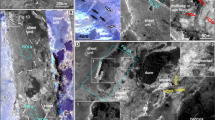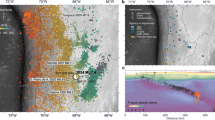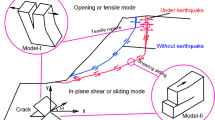Abstract
THE smallest Henbury meteorite crater contained1 a massive iron that had broken into four pieces weighing 132.7, 54.4, 10.9 and 2.3 kg, respectively. When these four pieces were excavated from the depths of the crater they were found to be still juxtaposed to one another. We have studied a 5 kg, 20×40 cm slice (BM 1932, 1359) taken from the largest of these pieces. We have also prepared and studied sections cut from a number of pieces of ‘shrapnel’ from a Henbury crater, weighing about 100 g and purchased from the American Meteorite Laboratory.
This is a preview of subscription content, access via your institution
Access options
Subscribe to this journal
Receive 51 print issues and online access
$199.00 per year
only $3.90 per issue
Buy this article
- Purchase on SpringerLink
- Instant access to full article PDF
Prices may be subject to local taxes which are calculated during checkout
Similar content being viewed by others
References
Spencer, J. L., Min. Mag., 23, 387 (1933).
Nininger, H. H., Ward's nat. Sci. Bull., 24, 21 (1950).
Brentnall, W. D., and Axon, H. J., J. Iron Steel Inst., 200, 947 (1962).
Author information
Authors and Affiliations
Rights and permissions
About this article
Cite this article
AXON, H., STEELE-PERKINS, E. Fracture mechanism of Henbury meteorite by separation along surfaces of shear faulting. Nature 256, 635 (1975). https://doi.org/10.1038/256635a0
Received:
Accepted:
Issue date:
DOI: https://doi.org/10.1038/256635a0



